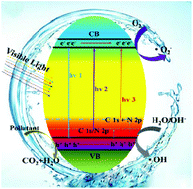当前位置:
X-MOL 学术
›
Dalton Trans.
›
论文详情
Our official English website, www.x-mol.net, welcomes your feedback! (Note: you will need to create a separate account there.)
C,N co-doped porous TiO2 hollow sphere visible light photocatalysts for efficient removal of highly toxic phenolic pollutants†
Dalton Transactions ( IF 4 ) Pub Date : 2018-03-15 00:00:00 , DOI: 10.1039/c8dt00262b Jiaqi Zhang 1, 2, 3, 4, 5 , Zipeng Xing 1, 2, 3, 4, 5 , Jiayi Cui 1, 2, 3, 4, 5 , Zhenzi Li 6, 7, 8, 9 , Siyu Tan 1, 2, 3, 4, 5 , Junwei Yin 1, 2, 3, 4, 5 , Jinlong Zou 1, 2, 3, 4, 5 , Qi Zhu 1, 2, 3, 4, 5 , Wei Zhou 1, 2, 3, 4, 5
Dalton Transactions ( IF 4 ) Pub Date : 2018-03-15 00:00:00 , DOI: 10.1039/c8dt00262b Jiaqi Zhang 1, 2, 3, 4, 5 , Zipeng Xing 1, 2, 3, 4, 5 , Jiayi Cui 1, 2, 3, 4, 5 , Zhenzi Li 6, 7, 8, 9 , Siyu Tan 1, 2, 3, 4, 5 , Junwei Yin 1, 2, 3, 4, 5 , Jinlong Zou 1, 2, 3, 4, 5 , Qi Zhu 1, 2, 3, 4, 5 , Wei Zhou 1, 2, 3, 4, 5
Affiliation

|
Herein, C,N co-doped porous TiO2 hollow sphere visible light photocatalysts were fabricated using biocompatible N-lauroyl-L-glutamic acid as a doped precursor and soft-template by a mild and facile self-assembly soft-template method, followed by calcination at 550 °C in air. The structure, morphology, and surface elemental composition were characterized in detail by X-ray diffraction, Fourier transform infrared spectroscopy, X-ray photoelectron spectroscopy, scanning electron microscopy, and transmission electron microscopy. The results show that the prepared TiO2 photocatalysts have a porous hollow sphere structure and are co-doped with C and N. The visible-light-driven photocatalytic degradation rates of phenol and 2-chlorophenol are ∼92 and 90%, respectively. The photocatalytic reaction rate constants of phenol and dichlorophen on HPT550 porous TiO2 hollow spheres were about ∼4 and ∼2 times higher than those on P25, respectively. This enhancement is because the C,N co-doped porous TiO2 hollow spheres not only extend the photoresponse to the visible light region as C,N co-doping narrows the bandgap (2.7 eV), but also expose a large number of surface active sites that favor visible-light-driven photocatalysis. Moreover, the porous hollow structure favors multiple reflections of photons in the interior, increasing the utilization ratio of light. It is worth to pay more efforts to the development of visible light photocatalysts and further promote their practical application.
中文翻译:

C,N共掺杂多孔TiO 2中空球状可见光光催化剂,可有效去除剧毒的酚类污染物†
本文以生物相容性N-月桂酰-L-谷氨酸为掺杂前驱体和软模板,通过温和简便的自组装软模板方法制备了C,N共掺杂的多孔TiO 2中空球形可见光光催化剂,然后在550°C的空气中煅烧。通过X射线衍射,傅立叶变换红外光谱,X射线光电子光谱,扫描电子显微镜和透射电子显微镜详细地表征了结构,形态和表面元素组成。结果表明,所制备的TiO 2光催化剂具有多孔空心球结构,并与C和N共同掺杂。可见光驱动的苯酚和2-氯苯酚的光催化降解率分别为〜92和90%。HPT550多孔TiO 2空心球的苯酚和二氯苯酚的光催化反应速率常数分别是P25的约4和2倍。这种增强是因为C,N共掺杂多孔TiO 2C,N共掺杂使能带隙(2.7 eV)变窄时,空心球不仅将光响应扩展到可见光区域,而且还暴露了大量有利于可见光驱动的光催化作用的表面活性位。而且,多孔的中空结构有利于光子在内部的多次反射,从而提高了光的利用率。值得为可见光光催化剂的开发付出更多的努力,并进一步促进其实际应用。
更新日期:2018-03-15
中文翻译:

C,N共掺杂多孔TiO 2中空球状可见光光催化剂,可有效去除剧毒的酚类污染物†
本文以生物相容性N-月桂酰-L-谷氨酸为掺杂前驱体和软模板,通过温和简便的自组装软模板方法制备了C,N共掺杂的多孔TiO 2中空球形可见光光催化剂,然后在550°C的空气中煅烧。通过X射线衍射,傅立叶变换红外光谱,X射线光电子光谱,扫描电子显微镜和透射电子显微镜详细地表征了结构,形态和表面元素组成。结果表明,所制备的TiO 2光催化剂具有多孔空心球结构,并与C和N共同掺杂。可见光驱动的苯酚和2-氯苯酚的光催化降解率分别为〜92和90%。HPT550多孔TiO 2空心球的苯酚和二氯苯酚的光催化反应速率常数分别是P25的约4和2倍。这种增强是因为C,N共掺杂多孔TiO 2C,N共掺杂使能带隙(2.7 eV)变窄时,空心球不仅将光响应扩展到可见光区域,而且还暴露了大量有利于可见光驱动的光催化作用的表面活性位。而且,多孔的中空结构有利于光子在内部的多次反射,从而提高了光的利用率。值得为可见光光催化剂的开发付出更多的努力,并进一步促进其实际应用。



























 京公网安备 11010802027423号
京公网安备 11010802027423号